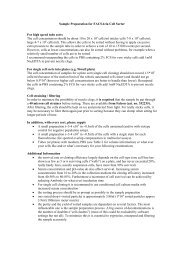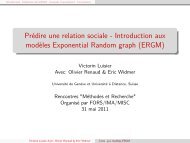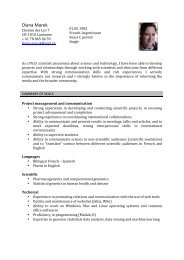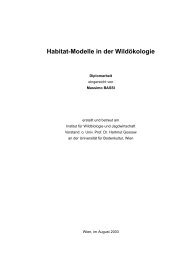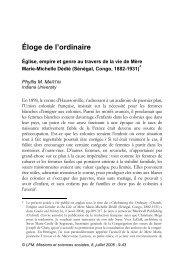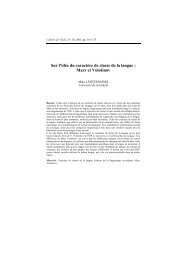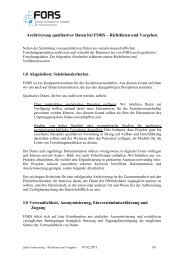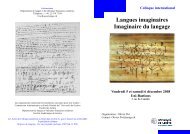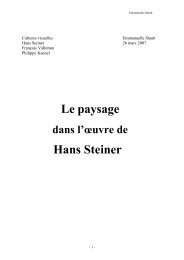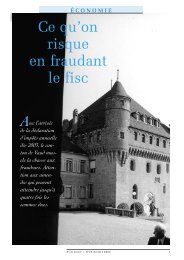conference programme book - European Survey Research ...
conference programme book - European Survey Research ...
conference programme book - European Survey Research ...
You also want an ePaper? Increase the reach of your titles
YUMPU automatically turns print PDFs into web optimized ePapers that Google loves.
38 TUESDAY 19 JULY1 GESIS - Leibniz Instute for the Social Sciences, GermanyDeveloping one item measures of reflecve psychological constructs with sufficient psychometric quality forsurvey research may be considered a crical research endeavor. By using the construct of Opmism-Pessimismas an example we demonstrate that this approach is possible and worthwhile. Opmism and Pessimism aredefined as generalized posive or negave expectancies concerning future events. Usually, both are measuredby a set of many items. As most surveys operate under severe me and/or monetary constraints we developedtwo single item indicators, one item to measure Opmism and one item for Pessimism.1.14.4 Assessing Schwartz’ global human values dimensions using a short scale for survey researchC. Beierlein 2 , C. Kemper 2 , A. Kovaleva 2 , B. Rammstedt 2 , S. Schwartz 11 Hebrew University of Jerusalem, Israel; 2 GESIS - Leibniz Instute for the Social Sciences, Germany<strong>Survey</strong> researchers have become increasingly interested in basic values in recent years as evidence that the10 human values proposed by Schwartz predict various polical and social atudes and behaviors across cultures.The ten values are usually assessed with the 40 item Portrait Value Quesonnaire (PVQ; Schwartz etal., 2001) or the 57 item SVS (Schwartz, 2006). However, social surveys oen require shorter, valid, and reliableinstruments due to limited resources of me and money. In order to construct such a short scale, thenumber of constructs assessed has to be reduced. Therefore, instead of assessing all ten values, we selectedPVQ-items that serve as good indicators for the four global value dimensions (Schwartz and Boehnke, 2004):Self-Enhancement, Self-Transcendence, Openness to change, Conservaon. We measure these four poles withone item from each of the two to three values that combine to form that pole...1.15 The process of quesonnaire design in a cross-naonal perspecveTo be held on July 19, 2011 from: 14:00 to 15:30, in room 340.Coordinated by:• Evi Scholz - GESIS - Leibniz Instute for the Social Sciences, Germany• Jessica Forn - GESIS - Leibniz Instute for the Social Sciences, Germany1.15.1 The ISSP Model of Mulnaonal Quesonnaire DesignN. Lewin-Epstein 11 Tel Aviv University, IsraelAs the methodology of populaon surveys establishes itself in a growing number of countries, mulnaonalcomparave surveys are becoming the primary mode of comparave research. The presentaon will discussthe ISSP which is an ongoing internaonal collaboraon currently encompassing instuons from 46 countries,all commied to comparave survey research. Member instuons of the ISSP annually field an agreed uponsurvey module agreed upon by majority vote and have been doing so for 25 years. The ISSP collaboraon israther unique in adopng a very democrac and parcipatory model for its development of survey topics andquesonnaire design. It is of interest, therefore, to introduce to a wide audience the principles and processthat adopted by the ISSP and to point out its strengths and weaknesses to potenal users and collaborators...1.15.2 Challenges in comparave quesonnaire design: Illustraons from the <strong>European</strong> Social <strong>Survey</strong>R. Fitzgerald 11 City University London, United KingdomA ’principle of equivalence’ or comparability underpins all high quality surveys. It demands that all membersof the relevant populaon have an equal (or at least a known, non-zero) probability of selecon, and that thequesons should have equivalent meaning for respondents. Such input equivalence is difficult to achieve in



